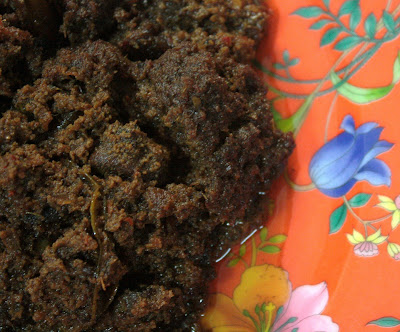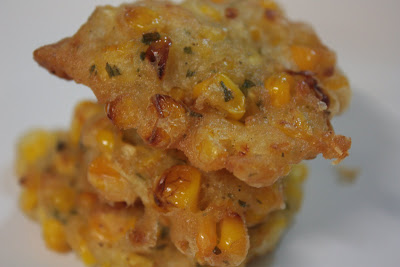

The
Minagkabau Rendang
Aahhh.............the Mother of all
Rendangs! Invented and spread by the
Minangkabaus as they ventured beyond their comfort zones into the Malay peninsula. Centuries ago. Resulting in the love and savouring of
the
rendang today all over Malaysia, by all Malaysians, of all races, and from all walks of life. So perhaps a short delve into the story of the
Minangkabaus as a people is not uncalled for here.
The
Minangkabaus are a people indigenous to the highlands of West Sumatra in Indonesia. They practice a matrilineal culture (apparently the world's largest matrilineal society) where property and land passes from mothers to daughters while their men dabble in religion and politics. Hmmmm.....that's
rendang for thought.
The name
Minangkabau is thought to be a conjunction of two words;
minang (victorious) and
kabau (buffalo). Legend has it that the name derived as a result of a territorial dispute between a neighbouring prince and the
Minagkabaus.
To avoid bloodshed (of the human kind of course) the two adversaries each put up a buffalo to a fight. And to cut a long legend short the
Minagkabau's buffalo emerged victorious and it was at that point that the
'Minagkabaus' were born; as in 'Victorious Buffalo'.
What they called themselves before that though is anyone's guess. But they were a proud people and were renowned as travellers and merchants. They travelled and set up communities in the Malay peninsula and in other parts of Indonesia and brought with them their particular foods that are very much enjoyed here today.

The picture above, taken from Wikipedia, shows a beautiful
Minangkabau 'Big House' or 'Rumah Gadang' designed in such a way that its roof was inspired by and took on the shape of the upward curve of a buffalo's horns. Further proof that the legend perhaps is a little more than mere legend.
Rendang is one of the characteristic foods of
Minagkabau culture, served during ceremonial occasions and to honour guests.
Although westerners might categorize
rendang as a curry,
rendang is in actual fact nothing like a curry, at least not in the way that it is cooked.
Rendang is cooked
very slowly in plenty (and I mean
really plenty) of coconut milk with a combination of spices and herbs for several hours until all the liquid has evaporated thus allowing the meat to soak in and absorb the flavours of all the condiments.
The cooking process begins as boiling but it changes eventually to frying as the liquid evaporates and the meat begins to cook in the oil of the coconut milk itself. There is no sauteeing of the spices in vegetable oil first, unlike in a curry, but the meat is simply boiled in the coconut milk with the spices and herbs thrown in.
What gives it its dark, deep and rich colour, which is an important characteristic of a good
rendang, is the result of the large amount of coconut milk used in proportion to the meat. The oil from the coconut milk after the liquid has evaporated 'fries' the meat to a dark, reddish brown.
The first squeeze of thick coconut milk from two mature grated coconuts to one kati (catty)(approximately half a kilogram) of meat is the normal ratio in a
Minang rendang recipe.
Kerisik (freshly grated or dessicated coconut dry fried to a golden brown and pounded to a paste) is quite unnecessary as the large amount of coconut milk and the oil obtained from it is more than sufficient to give the
rendang its dark and rich coconutty flavour.
History has it that the
rendang was thus cooked because it was the best way to preserve cooked food during times when refrigeration would have been unfathomable.
As a result, there emerged two kinds of
rendang, the wet and the dry. The wet lasting about a month if kept well and the dry lasting two to three months. The dry
rendang was usually served on ceremonial occasions and was a convenient dish to serve to visitors who dropped in unexpectedly over time.
Rendang was cooked using mostly beef or sometimes mutton, buffalo meat and also chicken or duck. But chicken or duck
rendang however has tamarind juice as an additional ingredient and does not require as long a cooking time as beef.
The downside of cooking a real
Minang rendang though is that it takes ages, hours, and the upside is that it is incomparable when it comes to flavour and taste!
As far as I am concerned, it's worth its wait in gold (pun intended).
 The Recipe......
The Recipe......
The large amount of onions used gives this dish its thick rich sauce and adds a savoury sweetness as it cooks and caramelizes with the other condiments towards the end of the long cooking. Kerisik (grated or dessicated coconut dry fried to a golden brown and pounded to a paste) is not necessary as this recipe includes plenty of thick coconut milk.
I kg. beef or mutton, cubed in sizeable chunks
400 gm large red onions or shallots
4 cloves garlic
1 1/2 inch galangal/lengkuas
1 1/2 inch ginger/halia
1/2 inch fresh tumeric/kunyit
2 stalks lemon grass/serai
8-10 pieces of *dried or fresh red chillies, or a combination, (more if preferred)
* dried chillies (soak in hot water to soften for 10 minutes before being ground)
**1200 ml thick coconut milk, preferably freshly squeezed, obtained from
4 grated coconuts
1 tumeric leaf
5-6 pieces kaffir lime leaves
2 tsp salt
**I have converted the previous measurement of 900-1000
grams of coconut milk to
milliliters and have specified the number of coconuts to be used for easier and more specific measuring.
Slice onions, garlic, galangal, ginger, tumeric and lemon grass and then grind them in a food processor ( my preference) or a blender, if you prefer, until it becomes a paste.
Put all ingredients - cubed meat, ground paste, tumeric leaf, kaffir lime leaves, santan and salt into a large pot or wok and bring to a boil. As soon as it comes to a boil lower heat and let it simmer for the rest of the cooking time until the mixture becomes a dark, dark, rich brown. This will be achieved as the colour changes shades through several stages in the cooking.
Stir every once in a while to ensure that the bottom does not get burnt or that the meat does not stick to the bottom of the pot or wok. The rendang is ready when the mixture becomes dark, rich and brown or if it is cooked to a drier stage the colour would be an even darker chocolate brown.
I actually cooked this yesterday for about four and a half hours. Don't let this discourage you though for it's worth the wait.
TIP* Through trial and error I have found that
rendang is best cooked in a heavy based wok or in a heavy based, wide mouthed pot as opposed to a high narrow pot. The larger surface area allows evaporation to take place more rapidly and the heat is not entirely concentrated on breaking down the meat inspite of the long cooking process. So you will still get a nice thick sauced
rendang while still maintaining chunks of meat satisfactorily intact.
TIP* Select rump, knuckle or topside for rendang, not sirloin. Sirloin is too tender to withstand the long cooking and you will probably end up with ground mush instead.
TIP* If packaged coconut milk is used instead of fresh, you may not end up with the glaze of oil towards the end of the cooking and the
rendang may not be satisfactorily dark or moist. This would probably be caused by the fact that packaged coconut milk has lost most of its natural oils after being processed.
The only way to overcome this problem is by sauteeing the ground ingredients in oil first, as you would a curry, then add the rest of the ingredients after which you should continue to cook it as you would a
rendang.
But the 'darkness' of the
rendang is also a result of the large amount of
fresh coconut milk used as it provides more oil for the meat to 'fry' in towards the end and therefore becoming darker. This means that even if you saute the ground ingredients in oil first the final product will still not be as dark brown as a dish that uses fresh coconut milk in the amount stated in the recipe above.
I am afarid all this obsession with darkness in
rendang has got to do with the fact that it is one of the means by which I judge a good rendang. Through experience, pale, light brown coloured rendangs never taste good let alone look good. Having learnt this recipe from a 'thouroughbred' elderly Minagkabau lady years ago I have set her
rendang as the 'GOLD STANDARD' in
rendang world.






















